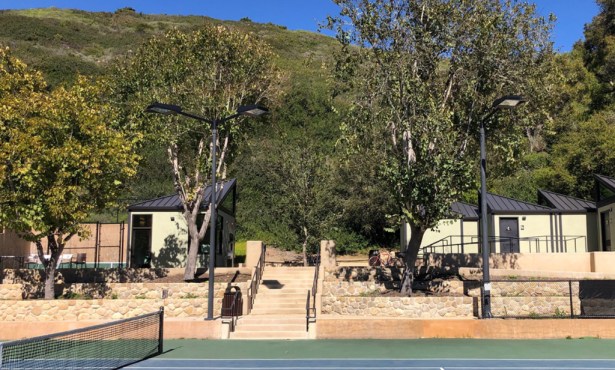First Clarity, Then onto the Next Thing
Stephen Petronio Reflects on the Challenge of Modern
Choreography
New York choreographer Stephen Petronio was the first male
member of the legendary Trisha Brown Dance Company, where he
performed between 1979 and 1986. He founded his own company in
1984, and has become one of the world’s most sought-after dance
artists. His work is hip, jarring and highly demanding, blending
modern fashion, new music and visual art with physically extreme,
highly technical movement. A collaborative artist, Petronio has
worked with American photographer and filmmaker Cindy Sherman, and
Spanish fashion designer Manolo Blahnik. His dances have been set
to the music contemporary composer and musicologist Michael Nyman,
and more recently with rockers Lou Reed and Rufus Wainwright. Last
week Petronio spoke about the company’s new season of touring, and
considered the ways in which the tone of his work has shifted in
recent years.
In Santa Barbara you’ll be showing your new work, BLOOM
and last year’s bud suite, both set to tracks by Rufus Wainwright,
as well as 1992’s Rite Part, set to Stravinsky’s Rite of Spring.
How’s the tour of that program going so far? Bloom
premiered in New York in April, and the company started this week
on a US tour that will go until next April. I love it. It has been
fantastic. Rite Part is pretty scary. It’s quite tense. BLOOM is
much more uplifting, so the mood moves over the course of the
evening. Our audiences seem engaged, especially in BLOOM. Rufus
wrote some incredibly beautiful and hopeful music.
How did the collaboration with Wainwright arise, and
what was he like to work with as an artist? He’s a great
musician, I love his music. I was working with Lou Reed a few years
ago and he wrote “The Balloon Song,” which was sung by Kate
Mcgarrigle. Right before the show, I found out that she was Rufus’s
mother. Rufus came and saw the work, liked it, and we started
talking about collaborating.
Why did you decide to involve the Young People’s Chorus
of New York City in BLOOM? What kind of impact did that have, and
how does it differ on tour? My idea for Bloom was to have
it surrounded by the vibe of youth. I wanted to collaborate with
Rufus, and I wanted to have a chorus as well. He loved the idea. He
wrote a full-on choral score—he’d never done anything like it, and
it was great to see him attack the problem. What happens is in some
cities is we engage a chorus, send out the score out and have them
rehearse in advance. In Santa Barbara, I think we’ll be using a
recording, where Rufus sings all the parts.
 Deborah Jowitt, longtime dance
Deborah Jowitt, longtime dance
critic at the Village Voice, has admitted your work scares the hell
out of her—why do you think that is? A lot of my work has
been made in anger, so the movement can be quite violent and
aggressive. There are a lot of near misses, and a driving force to
the work, especially the earlier work. In Rite Part, particularly
the last solo, I created an angry, hysterically empowered woman. I
think there’s a lot in the world to be mad about. I think most
artists’ work is like a scream in the void. With Right Part in
particular, it was about the concept behind Rite of Spring—having a
virgin sacrificed to perpetuate the agricultural cycle. I thought
about how angry I would be if I was a woman and that was the
scenario, so I made the most powerful and sexually aggressive woman
I could. It’s also the music that’s scary—the pianist pounds the
piano as if it’s a jackhammer. It’s percussive and violent.
That’s a piece of music that’s been used so often by
choreographers—was it intimidating to attempt to do something new
with such a well-exercised score? I felt the same
thing—Stravinsky’s Rite of Spring has been used a lot. At the time
I chose it, I knew very little about classical music, and I just
wanted to start with the hardest thing possible. I had to be brave
enough to try it. I think the sacred dance at the end is one of the
best things I’ve ever done. There’s no virgin being sacrificed in
mine. The woman dancing at the end of Rite Part is not giving
anything up. My work is pretty abstract—there’s really no
narrative.
Tell me about the impetus for bud—it started as a male
duet and has been extended to a four-part suite, right?
Yes—I was using these four tracks I took from Rufus before we did
BLOOM. I was doing it partly as a way to entice him and work with
his rhythms. I wanted to make a male duet where men were throwing
one another around—using all the playful and sensual implications
of that kind of interaction between two buddies. Then there’s a
female duet, a female quartet, and section for the whole company.
All four songs are about desire and about how people are together,
how they handle each other.
Going much further back in time to your early years as a
dancer, what aspects of Steve Paxton and Trisha Brown’s work do you
think you responded to initially? What do you think you took on as
your own? The investigation of movement and movement
invention—they pioneered that in a very specific way. I have
natural sequencing in my body and they both have that, too—a
sequencing through the spine and the limbs. It was a very natural
progression. Steve was improvising, so early on I got to
investigate a personal movement vocabulary of my own. Trisha was
improvising and then memorizing it, which encouraged me to begin to
set a movement language.
Can you elaborate on what you mean by a natural
sequencing in the body? Just like the alphabet goes from A
to Z, a movement ripples from my toe through my leg into my pelvis
through my ribcage and shoulder and out through my arm—it’s like a
wave of energy passing through the body. Stylistically I think I’ve
moved away from that work, though. I work with classical companies
too. I really steal from everybody. I think my work is much more
virtuosic than Steve and Trish’s stuff—I like that virtuosity. I’m
really interested in the look of virtuosity.
 Tell me a little about your
Tell me a little about your
interest in Kabbalah—how do those beliefs and practices intersect
with your approach to making art? I think everything
influences everything. I’ve been studying Kabbalah for over 10
years now. I think actually BLOOM might be more about light than
dark because of that—I think in the last 10 years I’ve become more
interested in making a positive contribution to the world, as well
as a disruptive contribution.
You’re 50 this year, am I right? What’s that landmark
like for you as an artist? Does it mean much to you? Yeah,
totally! I’m 50—I’m an old wise man now. (Laughs.) I still feel
like an idiot, and a child. But I wouldn’t have made BLOOM 10 years
ago. It’s pretty harmonic and symmetrical. I wouldn’t have let
myself do that before. I wasn’t mature enough, I wanted to mess up
the audience more than that, and deconstruct the stage. I think the
shift comes as much from years of experience as from my age
itself.
People refer to your work as provocative and
audacious—is that your intention? Do you want to shock or provoke?
There’s certainly an overtly sexual charge to your work—how does
that energy intertwine with the themes of youth and innocence in
bloom? I’m not interested in shock. I’m definitely
interested in prodding myself and others. I like going into new
territory, I like being disoriented, and disoriented audiences. I
think it’s important not to tell audiences what to think. That’s
not very interesting. Art is challenge—it should be bringing up
questions and causing arguments between people afterwards in the
lobby, not lulling them into agreement. That’s always been the
function of art in my life, and it has served me very well.
How has it served you well? It has pushed me
into territory I wouldn’t have gone to before. I love being
challenged, oddly confused, thinking that I don’t understand. You
come to clarity, then go on to the next thing. That’s how I work
with movement, too: I try to up the ante every year. I ask things
like, “How many beats per minute can we tolerate, how much
information can the body absorb when you’re making movement?” You
struggle with it, and then a few months later you think, “I found
that hard?” and you get it and go on to the next level with it.
It’s kind of an American thing I guess, but I think our capacity
for learning things is pretty infinite.
How do your dancers respond to that challenge?
I think they’re here for that very reason. The work is too hard—if
you’re lazy, you won’t make it through the first month. It’s not
for everybody.
How do you hope audiences will approach your
work? Open your eyes wide and don’t sweat it, just enjoy
it. That’s what it’s there for.
As well as to disorient us? Exactly. I like
being disoriented. I know that’s a little perverse. You ask some
good questions, I’ve really enjoyed that.



